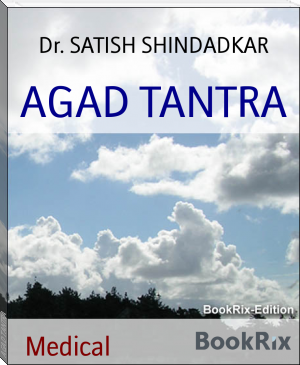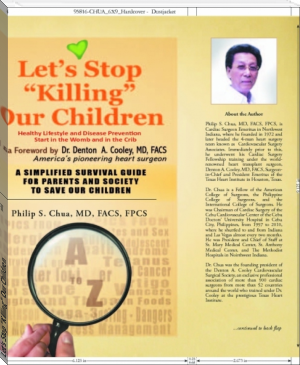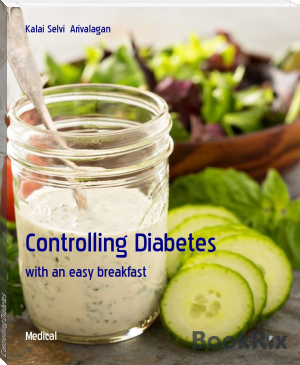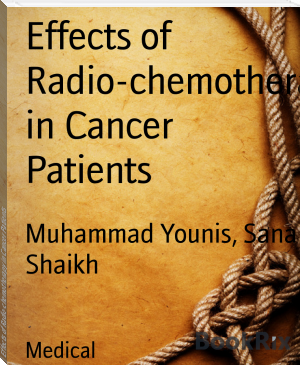AGAD TANTRA, Dr. SATISH SHINDADKAR [web based ebook reader .txt] 📗

- Author: Dr. SATISH SHINDADKAR
Book online «AGAD TANTRA, Dr. SATISH SHINDADKAR [web based ebook reader .txt] 📗». Author Dr. SATISH SHINDADKAR
Calcium & withdrawl of potassium are synergistic of digitalis.
विषाक्तता लक्षणे : GIT irritation.
Heart - decreased heart rate, may be heart blocks, extra systoles, ventricular fibrillation.
ECG - Flat or inverted T wave, depression of ST segment, prolonged P-R interval & shortened QT interval.
Pulse - Pulsus bigeminus.
Respiration - Slow & sighing.
Pupils - Dialated.
Patient becomes drowsy & the condition may gradually deepens into coma. Convulsions may precede death.
Treatment :
Gastric lavage.
Emetics.
Large doses of tannin.
Rest symptomatic treatment.
P.M. appearances : Not charcteristic.
Medicolegal Importance : Poisoning is rare. (Suicidal, homicidal & accidental.)
***
8 तन्त्रिका प्रभावक विषे (Neurotics)
Methyl alcohol (CH30H)
Classification - Neurotic cerebral inebriant poison.
Fatal dose - 1-2 ml/kg body wt. typically 60-200 ml.
10 ml pure methanol सेवनाने देखील विषाक्त लक्षणे उत्पन्न होऊ शकतात.
Fatal period – 1-3 days.
Methyl alcohol is also called as methanol, wood alcohol, wood naphtha & wood spirits.
Methanol is simplest alcohol & is light, volatile, colourless, flammable liquid with a specific odour like ethanol.
Mech of action: Accumulation of methanol & its metabolites formal dehyde & formic acid are very toxic to brain or optic nerve.
विषाक्तता लक्षणे -
Symptoms can appear after absorption from skin, respiratory tract & GIT.
Methanol can cause metabolic acidosis, neurological disorders & lastly death when ingested.
The initial symptons of intoxication include CNS depression, headache, dizziness, nausea, lack of co-ordination & confusion.
If ingested in large quantity it is metabolized to formic acid, which is poisonous to CNS & may cause blindness, coma & death.
Physical examination may show tachypnea (abnormally rapid breathing.). Opthalmological examination may show dialated pupils with hyperaemia (an excess of blood in a part) of the optic disc & retinal edema.
Methanol has a relatively low toxicity upon ingestion; methanol is quickly absorbed in the GIT & metabolized in liver.
व्यवच्छेदक निदान - Ethyl alcohol
Methanol
Ethyl alcohol
There are cramps in abdomen.
No cramps in abdomen.
It is toxic for optic nerve & blindness may occur.
Comparatively less toxic.
It highly toxic for CNS
Comparatively less toxic.
Metabolic acidosis is severe due to formic acid
Comparatively less acidosis
Accumulation of methanol & its metabolites in body hence highly toxic.
Comparitively fast excretion of metabolites of ethanol hence less toxic.
चिकित्सा -
- Gastric lavage with 5% NaHCO3 in warm water.
Antidote - ethyl alcohol - 1 ml/kg/day
as 10 % solution i.v. , for 5 days.
Treat acidosis - orally 2 gm of NaHCO3 in 250 ml of water.
i.v. 50 gm in 1 lit of 5 % Dexrose.
In servere case - Haemodialysis.
Symptomatic treatment.
P.M. appearances :
- Cyanosis
smell of alcohol.
Haemorrhage & congestion of GIT.
- Pulmonary & cerebral oedema, retinal oedema.
Mediocolegal importance:
Poisoning is mainly accidental.
Ethanol is sometimes adulterated & made poisonous by addition of methanol.
***
Ethyl alcohol. (ethanol, C2H5OH)
Classification - Neurotic cerebral inebriant poison.
Fatal dose - About 150-200 ml of absolute alcohol.
Blood alcohol level more than 0.7 %.
However it may be more for addict persons.
Fatal period – 12-14 Hrs.
Ethyl alcohol when pure is transparent, colourless and volatile, with aromatic (fruity) odour & burning taste.
Absolute alcohol is 99 % ethyl alcohol.
Mechanism of action:
Ethyl alcohol depresses the CNS irregularly in descending order from cortex to medulla.
State of excitement is due to removal of inhibitions.
Alcohol from blood passes into alveolar air through lungs, hence breath smells of alcohol.
विषाक्तता लक्षणे -
Acute poisoning - There are 4 stages.
1) Stage of excitement occurs when blood alcohol level 0.05 -0.1 %
There is feeling of well being & pleasure.
2) Stage of incoordination -occurs when blood alcohol level 0.1- 0.3 %
In co-ordination of thought, speech & action.
3) Stage of narcosis (coma) - occurs when blood alcohol level - 0.3 -0.5%
Patient is in deep sleep, responds only to deep stimuli. In this stage the characteristic sign is seen called -
Mac Ewan’s sign - On pinching the muscles of face or neck pupils are dialated & again become contracted on releasing the pinch.
4) Stage of medullary paralysis - occurs when blood alcohol level - 0.5 % & more.
Respiration is slow & Stertous (heavy snoring), pupils are dialated & there is abolition of reflexes.
D. D. : Methyl alcohol poisoning.
Treatment -
- Gastric lavage with 5 % solution of NaHCO3 in warm water.
- Avoid emetics
- Use of antabuse - 0.5 mg/day (Antabuse interferes with the metabolism of alcohol and is used to treat chronic alcoholism.)
- Symptomatic treatment.
Chronic Poisoning:
It is seen in alcohol abuse.
Mainly gastritis, pancreatitis, liver disorders like cirrhosis etc; altered gonadal function, loss of memory etc.
Pregnant ladies who drink heavily have mentally retarded child.
Mental syndromes like Delerium tremens, Korsakoff’s psychosis & acute halluinosis etc are seen in chronic poisoning.
Treatement :
Symptomatic treatment, psychotherapy.
P.M. appearances -
- Oedema of lungs & brain.
- hyperaemia & oedema of GIT
- Smell of alcohol.
- In chronic poisoning degeneration of brain.
Kidney & liver.
Medicolegal importance:
Death is rare due to ethyl alcohol.
There are increased chances of murder, rape, accidents & drawning etc.
मद्य व मदात्यय
मद्य गुण :
मद्याचे गुण विषाच्या गुणांच्या समान असतात परंतु, विषापेक्षा कमी प्रभावी असतात.
मद्य मात्रेत सेवन केल्यास अमृतासमान कार्य करते, तर अतिमात्रेत सेवनाने विषासमान घातक ठरते.
गुण - लघु सूक्ष्म आशु विशद उष्ण अम्ल विकाशी तीक्ष्ण व्यवायी रूक्ष
मदात्यय : - मद्याच्या अतिसेवनाने उत्पन्न लक्षणांना मदात्यय असे म्हणतात.
सामान्य लक्षणे (अ.सं. नि.6)
मोह, हृदयव्यथा, मलभेद, सतत तृष्णा, सौम्य व पित्तज ज्वर, शिर:शूल, पार्श्वशूल, अस्थिशूल, कंप, मर्मभेद, त्रिक्ग्रह, उर:विबंध, तिमिर, कास, श्वास, प्रजागर (रात्री झोप न येणे), अतिस्वेद, विष्टंभ, क्षवथु, चित्तविभ्रम, प्रलाप, छर्दी, उत्क्लेष, भ्रम, दु:स्वप्न इ.
प्रकार :
मदात्ययामध्ये त्रिदोषदुष्टी असते परंतु दोष प्रधानतेनुसार वातज, पित्तज, कफज व सन्निपातज असे चार प्रकार पडतात.
दोषांच्या आधिक्यानुसार, त्या त्या दोषांची लक्षणे आढळतात.
मदात्यय संदर्भात च.चि. 24 मध्ये :
अतिमद्यपानाने ओजक्षय होऊन सत्व गुण कमी होऊन मद उत्पन्न होतो. त्यामुळे शरीरातील सर्व धातू व मनामध्ये विकृती उत्पन्न होऊन त्याच्या पुढील 3 अवस्था उत्पन्न होतात.
1) प्रथम मद : या अवस्थेत मनुष्य आनंदी, उत्साही असतो. अन्नपान चवीने सेवन करतो. वाद्य, संगीत इ. मध्ये रस घेतो. या अवस्थेत बुद्धि, स्मृती, विषयग्रहण शक्ती उत्तम असते. सुखनिद्रा व जागृत होणे हे प्राकृत असते.
2) द्वितीय मद : या अवस्थेत स्मृतीभ्रंश होतो. असंबद्ध बोलणे-हालचाली इ. वाढतात. तर वरील प्रथम मदातील आनंदी गोष्टी विपरित होतात.
3) तृतीय मद : या अवस्थेत सर्वच अशुभ कार्ये घडतात. मद्याच्या चांगल्या गुणांचा उपयोग घेता येत नाही व शेवट उन्माद व मृत्यू मध्येच होतो.
चिकित्सा :
मदात्ययामध्ये ज्या दोषाची प्रधानता असेल, त्या दोषाची चिकित्सा प्रथम करावी.
सन्निपातज मदात्ययात प्रथम कफ नंतर पित्त- शेवटी वायूची चिकित्सा करावी.
मद्याच्या हीन, मिथ्या, अथवा अतिमात्रेत सेवनाने जे व्याधी उत्पन्न होतात, ते सर्व त्याच मद्याच्या सममात्रेत सेवनाने शांत होतात.
मदात्ययाची चिकित्सा साधारणत: 7 ते 8 दिवस करावी, यानंतर जी लक्षणे किंवा व्याधी शिल्लक राहतील त्यांची दोषानुसार चिकित्सा करावी.
Organo Chlorine Compounds - OCC
वर्गीकरण - स्थावर कृत्रिम विष - Neurotic Cerebral inebriant poison.
It is used in agriculture as pesticides and insecticides. The commonly used OCC are D.D.T., endrin, gammaxane, Dieldrin etc.
D.D.T.
Fatal dose - 150- 1000 mg/Kg body wt.
Fatal period - within one hour.
Route of exposure
Symptoms
Treatment
Ingestion
Salivation, nausea, vomitting, abdominal pain
Gastric lavage
Demulscents are contra
indicated.
Inhalation
Irritation of eyes, nose and throat, dialated pupils blurring of vision, cough, pulmonary oedema,
dermatitis, restlessness, hyperirritability, inco-ordination, muscle spasm, tremors, convulsions, depression, paralysis of limb muscles, collapse,
cyanosis, death due to respiratory failure
Artificial respiration and oxygenation, symptomatic treatment
Skin
same as above
Wash with soap water Rest symptomatic treatment
Chronic exposure
Anorexia, loss of weight , emaciation, anaemia, liver and kidney damage, CNS disturbances, skin irritation
further exposure should be avoided -symptomatic treatment should be given
P.M. findings:
Acute: Signs of asphyxia, Gastric mucosa is congested; stomach gives smell of kerosene and pulmonary oedema.
Chronic: Liver and kidney shows necrosis and degenerative changes. Heart shows fatty changes.
Medicolegal Importance:
1. Easily available hence used for suicidal purpose.
2. Accidental poisoning due to absorption through skin and inhalation.
Endrin
Fatal dose: 1-6 Gms.
Fatal period: 1/2 hr to several hrs.
Signs and symptoms:
Routes of exposure are ingestion, inhalation and skin contamination. Main symptoms are vomitting, abdominal pain, tremors, and convulsions, froath at nose and mouth which is fine white or blood stained. Gradually convulsions become severe, coma and finally death with respiratory failure.
Treatment: Symptomatic treatment should be given.
P.M. Findings:
Signs of asphyxia
Kerosene like smell from mouth & nostrils even in decomposed bodies.
Petechial haemmorrhage is common in lungs and heart.
Lungs appear large and bulky.
Pulmonary oedema and all organs are congested.
Medicolegal importance:
- Freely available and cheap hence commonly used for suicide.
- Homicideal use is common.
- Accidental poisoning due to absorption through skin and inhalation.
***
Organophosphorus compounds [OPC]
Classification : Neurotic cerebral inerbriant poison.
They are used as insecticides & pesticides in agriculture. Organophosphates are one of the most common causes of poisoning worldwide.
Exposure to organophosphates occurs on a daily basis through inhalation, absorption & ingestion of organophosphate treated food.
Exposure of OPC can occur at public places, residential areas, agriculture areas etc.
Fatal dose : Varies between 25 mg to 1 gm.
Fatal period: 1/2 - 3 hrs.
Mechanism of action: They are irreversible competitive inhibitors of enzyme Acetyl Cholinesterase. Site of action is myoneural junction & synapses of ganglion.
Signs and Symptoms:
Symptoms of OPC poisoning can be divided into 3 classes.
Muscarinic effects
Nicotinic effects
CNS effect
Cardiovascular-
bradycardia,
hypotension
Respiratory -
Rhinorrhea, bronchorrhoea
bronchospasm, cough
severe respiratory
distress, laryngeal
Spasm, respiratory
failure etc
GIT - Hypersalivation,
Nausea, vomitting, abdominal pain, diarrhoea, fecal incontinance.
muscle fasciculations, Cramping, weakness,
diaphragmatic failure,
hypertension,
tachycardia,
mydriasis, pallor,
Paralysis of
respiratory or
pharyngeal muscles,
Paralysis of sphincters, dyspnoea,
cyanosis
anxiety, emotional liability,
restlessness, Confusion, ataxia, tremors,
Seizures, coma, ototoxicity,
Respiratory paralysis
Genitourinary - incontinance & frequency of micturation.
Ocular - blurred vision, miosis,
Increased lacrimation increased sweating.
Muscarinic effects can be summarised:
SLUDGE
DUMBELS
Salivation
lacrimation
Urination
Diarrhoea
GI upset
emesis
diaphoresis, diarrhoea
urination
miosis
bradycardia, bronchospasm, bronchorrhoea
Emesis excess lacrimation, Salivation.
Differential Diagnosis:
Viral gastroenteritis
Mushroom toxicity.
Treatment -
1) Decontamination - Patient removed from source, remove clothes. Wash skin with soap & water. Gastic lavage. Emetics.
2) Care of airway & artificial respiration.
3) Antidote i) Atropin blocks muscarinic effects.
ii) Cholinesterase reactivator - Oxime compounds are used e.g. Protopam P2AM
4) Symptomatic treatment.
P.M. appearance:
- Signs of asphyxia
- Cyanosed face.
- Froath at nose & mouth.
- Stomach contents are blood stained with kerosene like or garliky smell.
- Mucosa is congested & submucous petechial haemorrhage.
- Pulmonary & cerebral oedema.
- Petechial haemmorrhages & hyperaemia of lungs, brain & other viscera.
Medicolegal Importance:
1) As it is easily available it is frequently used as suicidal agent.
2) Poisoning is common worldwide.
3) Readily used for homicide & cattle poisoning.
4) Accidental poisoning is very common.
5) Since it is deposited in body fat, it may be released into body at a later stage leading to delayed death.
OPCs also have toxic effects on reproductive system (birth defects), kidney, liver etc. It is also supposed to be a possible carcinogen.
***
Kerosene
वर्गीकरण - स्थावर कृत्रिम विष - Neurotic cerebral inebriant poison.
Petroleum contains gas & liquid constituents. It is an oily liquid found under the ground in several parts of the earth.
The refined oil from petroleum is known as kerosene also called lamp oil or coal oil.
Fatal dose: 15-30 ml.
Fatal period: few hrs.
Mechanism of action:
They depress CNS & act as irritants, because they dissolve fat.
The effects on liver, kidney & bone marrow may be due to contaminants as benzene.
Signs & symptoms:
- Kerosene taste & smell.
- Burning sensation in upper GIT.
- Nausea, vomiting, colicy pain & diarrhoea.
- Respiration becomes slow & shallow, cyanosis, Bronchopneumonia, & pulmonary oedema.
- CNS depression, covulsions & coma.
- Pupils are initially constricted. Finally become dialated.
- On contact with skin - skin becomes dry & rough.
- On contact with eye - there is redness in eyes.
- On inhalation: Nausea, vomitting, headache, dizziness & convulsions.
If kerosenc gets into lungs (aspiration), permanent lung damage can occur, chronic poisoning may occur due to inhalation, in people handling petrolium products.
The symptoms include dizziness, weakness, weight loss, anaemia, and nervousness, pain in limbs, peripheral numbness & paraesthesias (an abnormal sensation such as tingling, tickling, pricking, numbness or burning of a person's skin with no apparent physical cause.)
Treatment -
- Gastric lavage with warm water or NaHCo3
- 250 ml of liq. paraffin orally to dissolve kerosenc & it slows its absorption, followed by saline cathartic.
- If inhaled - Fresh air rest.
artificial respiration & oxygenation.
- Rest symptomatic treatment.
P.M. Findings:
- Kerosene smell.
- Features of gastroenteritis.
- Signs of asphyxia, pulmonary oedema.
- Degeneration of liver, kidney & hypoplasia of bone marrow.
Medicolegal importance :
1) Kerosene is occasionally used for suicidal purposes.
2) Homicidal use is common.
3) Accidental poisoning occurs - children drinking by mistake.
Adult drinking it mistaking it for country liqour.
Ingestion on inhalation, while removing from car tanks.
4) Chronic poisoning occurs due to inhalation of fumes in industry.
5) Contaminated water may





Comments (0)